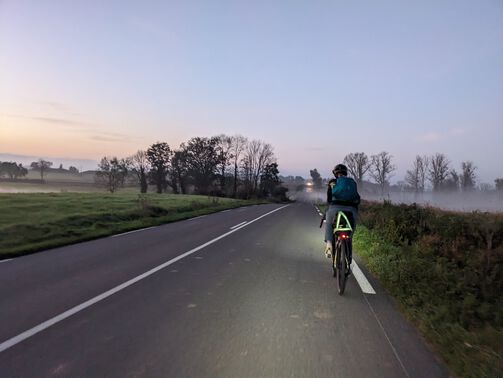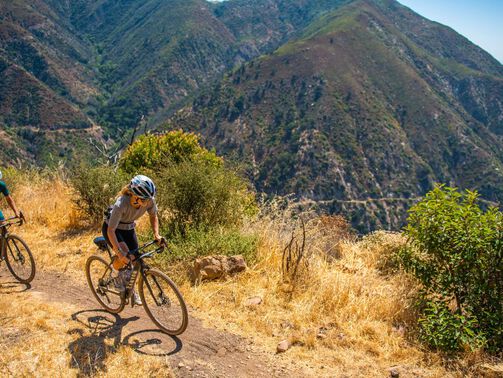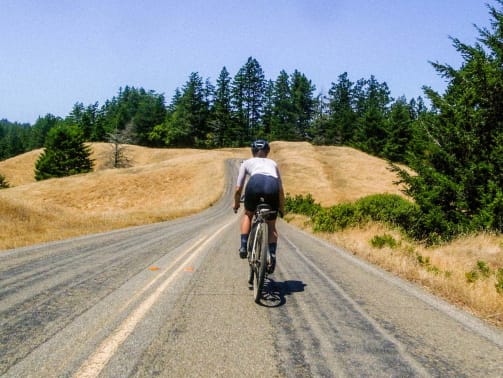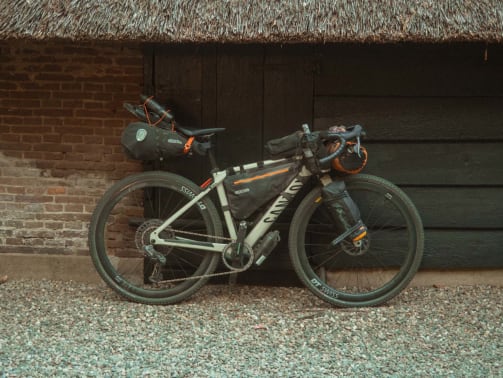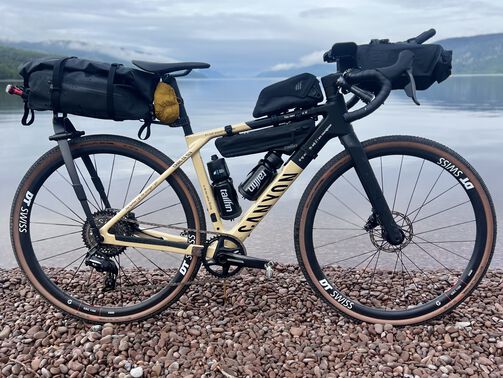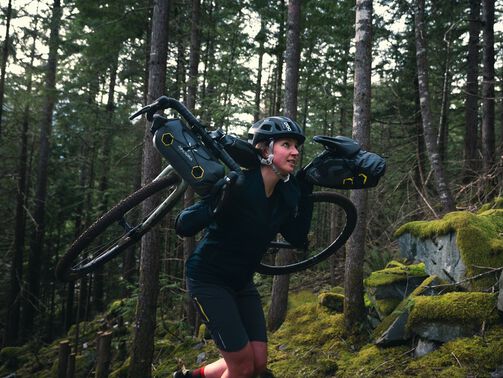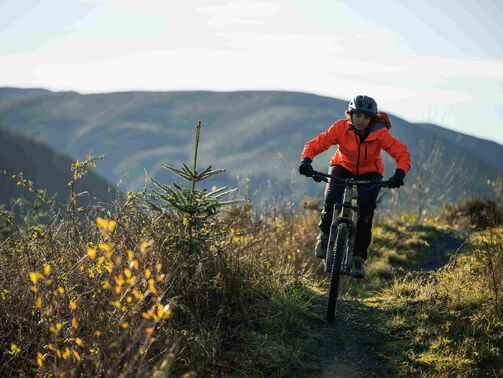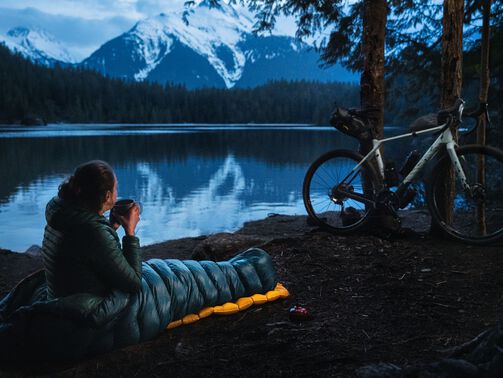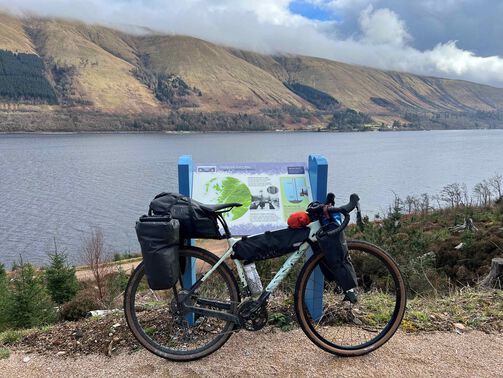Bikepacking 101 – your complete guide to adventure by bike
If you’ve indulged in the world of cycling long enough, you’ve definitely come across the term ‘bikepacking’ enough times. But what actually is it? Here’s your ultimate Bikepacking 101.
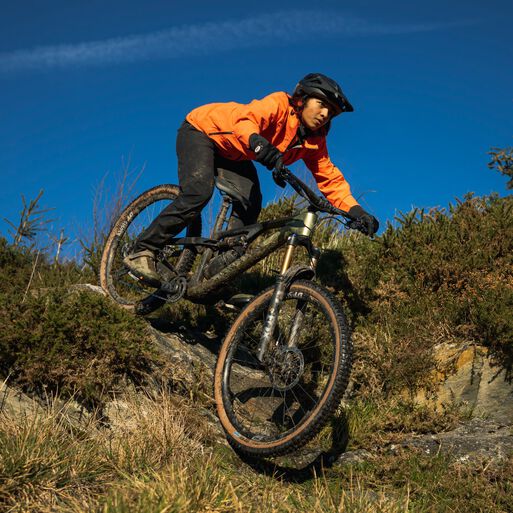

In this guide, we’ll walk you through everything you need to know to get started with bikepacking – from choosing the right bike and setting it up for adventure, to selecting essential gear that keeps you comfortable and efficient on every ride.
We’ll also cover how to plan your bikepacking route, train for long-distance cycling, and pack smart so you’re ready for any challenge on the road or trail.
Contents
What is bikepacking?
Bikepacking means a multi-day cycling adventure on a bike loaded with a lightweight and minimalist setup of gear that you need to survive.
This approach allows you to access remote wilderness areas and technical trails while maintaining better bike handling and a streamlined profile.
At its core, bikepacking is an adventure sport that prioritises exploration and comfort. Here are some key elements of bikepacking that you need to know:
- Self-supported adventure: you carry everything needed for multi-day trips without external support
- Usually over longer distances: regardless of the choice of terrain, you can go generally farther and move relatively quicker than cycle touring
- Minimalist approach: frame-mounted bags and ultralight gear instead of heavy panniers or racks
- Terrain variety: ability to access remote areas beyond what's possible with traditional road touring setups
The origins of bikepacking
Bikepacking evolved from the mix of traditional cycle touring and mountain biking culture during the 1990s and early 2000s. While cyclists had been carrying gear on bikes for over a century, bikepacking as we know it today emerged when the advances in ultralight outdoor gear made it possible to pack everything needed for multi-day adventures into compact, frame-mounted bags.
This shift represented a departure from the heavy, comfort-oriented panniers and racks of traditional touring toward a lightweight, minimalist philosophy that prioritised access to technical terrain and remote wilderness areas.
The growth of online communities and inspiring route documentation helped transform bikepacking from a niche activity into a global movement that is thriving among amateur adventurers.
How is bikepacking different from cycle touring
Bikepacking evolved from traditional cycle touring to meet the rider’s desire for mixed terrain adventure and lighter, more nimble travel. While both involve multi-day long distance bicycle journeys, several key distinctions set them apart:
- Weight distribution: Bikepacking keeps weight centred on the frame for better handling on technical terrain, while touring uses low-mounted panniers for stability on roads.
- Terrain capability: Bikepacking setups tend to be designed for narrow trails, rough surfaces, and challenging terrain that would be problematic for wide pannier systems.
- Gear philosophy: Bikepacking focuses on multi-use, lightweight items that prioritise function over full-scale comfort, whereas touring leans more towards ‘carrying the kitchen sink’.
- Bag systems: Frame bags, seat packs, and handlebar rolls replace racks and panniers, creating a streamlined profile that doesn't interfere with pedalling or catch on trail obstacles.
This evolution has made bikepacking accessible on terrain previously impossible for loaded touring bikes, opening up wilderness areas and every type of terrain to multi-day adventures.
Choosing the right bike for bikepacking
Your best bike for a bikepacking adventure is the one that offers comfort, stability, and multiple mounting points for attaching bags and gear securely. Gravel bikes offer the versatility of handling mixed terrain while also offering wide tire clearance, stable handling when loaded, and mounting points for frame bags, water bottles, and additional gear. If your bikepacking adventure is entirely off-road and crossing gnarly mountain passes or sketchy trail conditions, a mountain bike will do a better job.
For example, if you're planning a bikepacking adventure in the wilderness of Iceland or in the Scottish backcountry, a bike like Canyon Exceed or Grand Canyon would be an excellent choice. But say you're planning an adventure where you’ll be cycling across different terrains, hopping between road, gravel and singletrack trail, a Canyon Grizl or Grail will offer the versatility that you need.
The Canyon Grizl is designed for bikepacking adventures. It is very adaptable, with 50mm tyre clearance, additional fork mounting points for you to attach gear to, and has a geometry optimised for loaded riding on rough terrain. On top of that, if you want dynamo lights and a charging setup, then there are new Grizl models with ECLIPS technology that offer just that.
For a comprehensive analysis of bike selection criteria, frame materials, and specific model comparisons, check out our detailed guide on how to choose the best bike for bikepacking for expert insights on matching your bike to your adventure style.
Essential bikepacking gear and setup
This bikepacking 101 guide wouldn’t be complete without some crucial advice about your setup. Your next bikepacking adventure will need a well-planned gear system that balances weight, accessibility, and functionality. Essentially, your ideal bikepacking setup will involve strategically placed bags that utilise every available space on your bike frame.
Frame bags
Frame bags represent the heart of any bikepacking setup, utilising the main triangle space between your top tube, seat tube, and down tube. These bags excel at carrying heavy, dense items like tools, spare parts, food, and electronics because they keep weight centred and low, maintaining your bike's natural handling characteristics. Unlike external bags that can sway or create wind resistance, frame bags become an integral part of your bike's structure and don't interfere with pedalling motion or leg clearance. A well packed frame bag provides stability and accessibility.
Seat packs
Seat packs attach underneath your saddle and extend rearward, creating ideal storage for bulky but lightweight items such as sleeping bags, extra clothing, and shelter. These bags typically range from 8-20 litres and excel at carrying compressible gear that doesn't need frequent access during riding. Proper weight distribution is crucial with seat packs.
Overloading them can create unwanted sway and that affects bike handling, particularly on climbs and technical descents. Size limitations matter significantly with seat packs, as bags that extend too far behind the saddle can interfere with dismounting or create clearance issues.
The sweet spot involves matching bag capacity to your actual gear needs rather than maximising volume. Usually, a seat pack has extra adjustable cords on top that you can attach your jacket or food or anything that needs to be accessed quickly.
Handlebar rolls for lightweight essentials
Handlebar bags and rolls carry items requiring quick access during rides, such as snacks, maps, rain gear, and extra layers. These bags mount either directly to handlebars or use a roll-top system with a dry bag sleeve.
Weight limits become particularly important for handlebar bags since excessive weight can negatively impact steering, especially on technical terrain. Most experienced bikepackers recommend keeping handlebar loads under 3-4 kg to maintain responsive handling.
A heavy front end could easily give you speed wobbles on fast downhills. If you’re unsure whether your setup is too heavy, just ask yourself how well your bike would cope if you had to push your bike through sand or carry it over your back up a mountain pass.
Minimal camping gear selection
When bikepacking, you’re generally aiming to carry camping gear that’s lightweight and packs compact.
- Shelter: Lightweight tent, bivvy sack, or tarp system.
- Sleep system: Compact sleeping bag rated for expected conditions plus lightweight inflatable sleeping mat.
- Cooking: Minimal stove setup with titanium cookware, or cold food options to eliminate cooking gear entirely.
- Clothing: Stick to multi-use, quick-dry clothing only. Where possible, avoid cotton and pack versatile layers.
- Tools: Comprehensive multi-tool, tyre repair kit, chain links, and bike-specific spare parts
How much does bikepacking gear cost to get started?
Basic bikepacking gear including bags, minimal camping equipment, and essential tools typically costs €500-1000 for a complete setup. However, if you’re looking to go bikepacking on a budget, we have written a whole guide on how you can go about it, including tips regarding using borrowed gear, repurposing existing camping equipment, or choosing budget alternatives.
Many cyclists begin with a basic seat rack and stuff sacks for around €100, allowing them to test their interest in bikepacking before investing in specialised gear. Ideally, you should start simple and upgrade components as you gain experience and identify your specific needs and preferences.
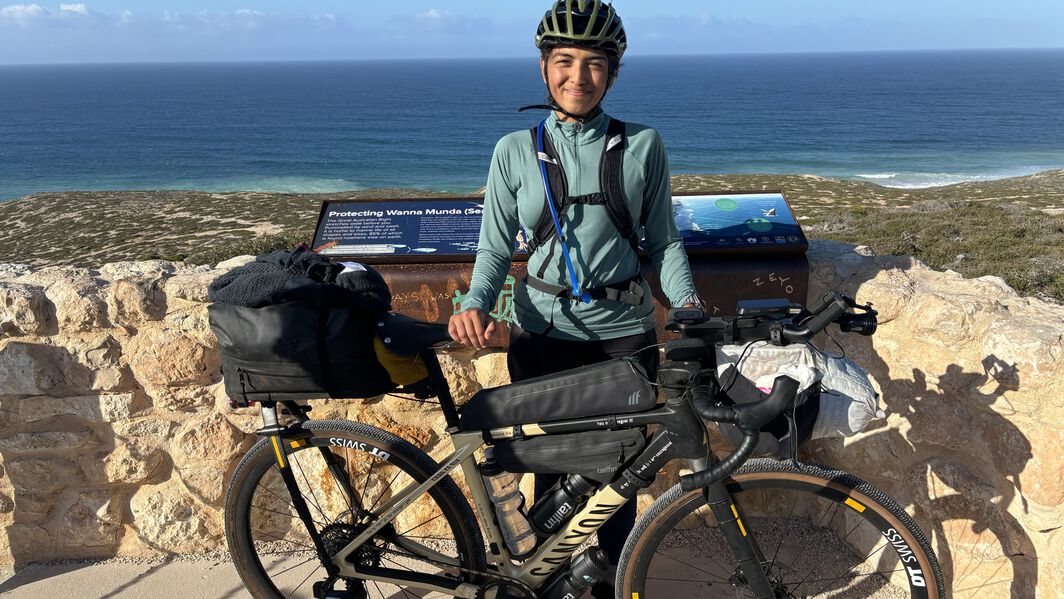
Planning your bikepacking routes and trips: what to be ready for
Your bikepacking adventure planning begins with a solid route plan, involving careful consideration of terrain, distance, resupply options, and camping opportunities. Along with this, consider whether you’re heading out on a solo bikepacking adventure or if you’ll have some buddies with you. Effective planning balances ambition with realistic assessment of your skills and conditions, while building in flexibility for weather changes or mechanical issues. The process involves mapping navigation systems, identifying water sources, researching local regulations, and establishing emergency communication plans.
For comprehensive guidance on route selection, navigation tools, resupply strategies, and emergency preparedness, check out our detailed route planning guide that covers everything from digital mapping tools to reading topographic features and assessing trail conditions.
Do you need special permits for bikepacking?
Permit requirements for bikepacking can vary significantly depending on your route. Many established bikepacking routes utilise public lands, passing via campgrounds. Research regulations for your specific route before departing, as some areas require advance reservations, have seasonal closures, or limit group sizes.
For example, Scotland offers unique access rights through the Land Reform Act, giving cyclists broad permissions to camp responsibly. Across Europe, rules differ by country - some allow wild camping with few restrictions, while others limit it to designated areas, so always check before you camp. In the U.S., bikepackers can often stay on public lands managed by the Bureau of Land Management (BLM) or in national forests, though certain wilderness zones may require permits. As a rule of thumb, when camping outdoors, you should follow the ‘Leave No Trace’ principles.
Safety considerations for bikepacking
Your safety when you're out and about on your bikepacking adventure extends beyond mechanical preparedness to include navigation redundancy, first aid skills, and wildlife awareness. Essential safety practices include carrying backup navigation systems (GPS device plus paper maps), informing someone of your planned route and expected return, and carrying appropriate emergency communication devices like satellite messengers in remote areas.
Wildlife safety varies by region but generally involves proper food storage in bear country, carrying bear spray where appropriate, making noise to avoid surprising animals, and maintaining distance from all wildlife. Some areas may have stray dogs. It's important to remain calm if you're chased. Stop and walk through their territory. Keep the bike in between you and the dogs.
If you're cycling through Australia or New Zealand in springtime, remember that there are some rather territorial magpies that will stop at nothing to get you out of their area. They swoop at your head mostly, but can also attack your eyes or ears, so it's important to keep those areas protected. Put some zip ties on the top of your helmet or even stick eye-like stickers to the back of your helmet to halt them. Again, panicking will get you nowhere with magpies.
First aid preparation should address common bikepacking injuries like cuts, sprains, and dehydration. More remote routes may require advanced wilderness first aid training or knowledge and activity-specific supplies

Bikepacking tips for beginners
If you’re right at the beginning of your bikepacking journey, you should build your skills progressively while learning what works with your riding style and adventure goals. The key to success lies in testing your setup thoroughly, packing efficiently, and developing essential mechanical skills before heading into remote areas. Consider training specifically for your long distance bikepacking adventure to make the most out of it.
Test your bikepacking setup locally
Never debut untested gear on a remote adventure. Go on a couple of overnight shakedown trips, even if they’re quick ones within 30 kilometres of home. While out on these rides, evaluate gear fit, comfort levels, packing efficiency, and bike handling with your full load. This is where you’ll find out those crucial details like whether your seat pack interferes with pedalling, if your frame bag rubs against your knees, or if your handlebar setup affects steering responsiveness. Use these nearby adventures to practice camp setup routines, test your cooking system, and identify any gear gaps before committing to longer, more remote routes.
Pack light and smart
Every additional gram matters when climbing loaded, making strategic weight reduction essential without compromising safety. Aim for roughly one-third of the total weight of the gear in your frame bag, one-third in your seat pack, and one-third between handlebar bags and other locations.
Ruthlessly evaluate each item's necessity- can it serve multiple purposes? Is there a lighter alternative? Can you resupply rather than carry it? If your friends are joining you on the next adventure, consider sharing gear to reduce individual loads.
Practice basic repairs
Mechanical problems become exponentially more serious when you're far from help on a remote trail. Make sure that you're familiar with essential repair skills including fixing flat tyres quickly, adjusting brake and derailleur settings, repairing broken chains, and addressing common issues specific to your bike and components. Carry bike-specific tools and spare parts, but more importantly, practice using them in comfortable settings before needing them in challenging conditions.
To help you prepare, check out our detailed guide on how to perform a proper bike check before every ride - it’s the best way to prevent most issues before they happen.
Stay flexible with plans
Weather changes, mechanical issues, fatigue, and route conditions frequently require plan modifications during bikepacking adventures. Build flexibility into your itinerary by identifying alternative camping spots, shorter route options, and potential exit points back to civilisation. Research multiple resupply locations rather than depending on a single store or facility, and maintain realistic daily distance goals that allow for unexpected delays. Embrace adaptability as part of the adventure.
Take care of nutrition and hydration
Your body will need significantly more fuel when you're riding with a loaded bike. It's important to be strategic with nutrition planning to maintain energy levels throughout long days. Aim for a consistent carbohydrate intake while riding, combined with adequate protein for recovery and fats for sustained energy. Make sure you're hydrating adequately, especially in hot conditions or high altitudes. Start early to avoid afternoon heat, take regular breaks every hour to assess nutrition and hydration status, and listen to your body's signals before small issues become significant problems. Take electrolytes often, mixed in with water. On routes with uncertain water sources, carry water filtration systems.

Your pre-ride bikepacking checklist and inspiring routes to get started
Proper pre-departure preparation prevents most bikepacking problems and ensures you're equipped for various scenarios that may arise during your adventure. Make a checklist and include your gear check, route confirmation, weather assessment, and emergency preparations.
The best part about any bikepacking adventure is planning your route. Nothing beats sitting with a map of the place that you’ve always wanted to visit and plotting your potential route options. This is where your adventure dreams will come alive and turn into plans.
Whether you already know where you want to go or it's your first ever bikepacking adventure, websites like Komoot and Bikepacking.com will have plenty of route ideas to explore.
Local cycling clubs can also offer you some advice based on your experience and ability levels. Additionally, you can also look into regional bikepacking forums to offer invaluable local knowledge about seasonal conditions, permit requirements, and hidden gems that official sources might miss.
Your next bikepacking adventure starts here
A bikepacking adventure can take you to incredible places. It offers a unique way to explore landscapes and challenge yourself while connecting with nature.
Getting started requires the right bike, essential gear, and most importantly, a spirit of adventure along with realistic preparation. It’s not the expensive equipment that’ll save the day or make the adventure enjoyable, but good planning, progressive skill building, and embracing the learning process.
Canyon's commitment to creating bikes that excel in demanding conditions extends beyond manufacturing. Our bike finder tool can help you find the perfect bike for you, matching your specific needs to the ideal model. If you’re still unsure, take a look at some of our buyers guides for gravel bikes and mountain bikes. You can also find Canyon communities connecting riders worldwide and sharing routes, advice, and inspiration.
Now that you’ve got the Bikepacking 101 guide, go explore the world – whether on an overnight adventure or riding across a continent.
Discover our Gravel Bikes
Did this article help?
Thank you for your feedback
-
 About the author
About the authorVedangi Kulkarni
Discover the inspiring story of Vedangi Kulkarni, the youngest woman to cycle around the world solo and unsupported. This adventure-loving endurance athlete, public speaker, and writer is also a business owner and expedition manager. When she's not exploring the world, she's diving into philosophical and nature writing books or researching the Arctic.




